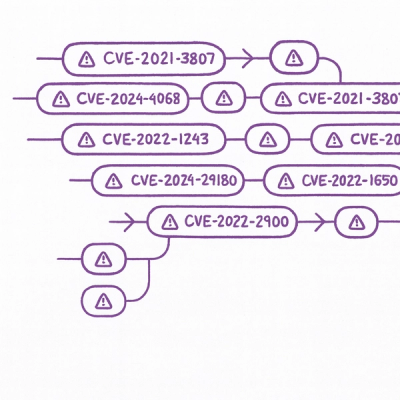
Security News
New Website “Is It Really FOSS?” Tracks Transparency in Open Source Distribution Models
A new site reviews software projects to reveal if they’re truly FOSS, making complex licensing and distribution models easy to understand.
PacketGen provides simple ways to generate, send and capture network packets.
PacketGen depends on PcapRub, which needs pcap development files to install. On Debian, you have to do:
sudo apt install libpcap-dev
Installation using RubyGems is then easy:
gem install packetgen
Or add it to a Gemfile:
gem 'packetgen'
PacketGen.gen('IP') # generate a IP packet object
PacketGen.gen('TCP') # generate a TCP over IP packet object
PacketGen.gen('IP').add('TCP') # the same
PacketGen.gen('Eth') # generate a Ethernet packet object
PacketGen.gen('IP').add('IP') # generate a IP-in-IP tunnel packet object
# Generate a IP packet object, specifying addresses
PacketGen.gen('IP', src: '192.168.1.1', dst: '192.168.1.2')
# get binary packet
PacketGen.gen('IP').to_s
# send Ethernet packet
PacketGen.gen('Eth', src: '00:00:00:00:00:01', dst: '00:00:00:00:00:02').to_w
# send IP packet
PacketGen.gen('IP', src: '192.168.1.1', dst: '192.168.1.2').to_w
# send forged IP packet over Ethernet
PacketGen.gen('Eth', src: '00:00:00:00:00:01', dst: '00:00:00:00:00:02').add('IP').to_w('eth1')
# send a IEEE 802.11 frame
PacketGen.gen('RadioTap').
add('Dot11::Management', mac1: client, mac2: bssid, mac3: bssid).
add('Dot11::DeAuth', reason: 7).
to_w('wlan0')
packet = PacketGen.parse(binary_data)
# Capture packets from first network interface, action from a block
PacketGen.capture do |packet|
do_stuffs_with_packet
end
# Capture some packets, and act on them afterward
packets = PacketGen.capture(iface: 'eth0', max: 10) # return when 10 packets were captured
# Use filters
packets = PacketGen.capture(iface: 'eth0', filter: 'ip src 1.1.1.2', max: 1)
# access header fields
pkt = PacketGen.gen('IP').add('TCP')
pkt.ip.src = '192.168.1.1'
pkt.ip(src: '192.168.1.1', ttl: 4)
pkt.tcp.dport = 80
# access header fields when multiple header of one kind exist
pkt = PacketGen.gen('IP').add('IP')
pkt.ip.src = '192.168.1.1' # set outer src field
pkt.ip(2).src = '10.0.0.1' # set inner src field
# test packet types
pkt = PacketGen.gen('IP').add('TCP')
pkt.is? 'TCP' # => true
pkt.is? 'IP' # => true
pkt.is? 'UDP' # => false
# encapulsate/decapsulate packets
pkt2 = PacketGen.gen('IP')
pkt2.encapsulate pkt # pkt2 is now a IP/IP/TCP packet
pkt2.decapsulate(pkt2.ip) # pkt2 is now inner IP/TCP packet
# read a PcapNG file, containing multiple packets
packets = PacketGen.read('file.pcapng')
packets.first.udp.sport = 65535
# write only one packet to a PcapNG file
pkt.write('one_packet.pcapng')
# write multiple packets to a PcapNG file
PacketGen.write('more_packets.pcapng', packets)
PacketGen permits adding your own header classes.
First, define the new header class. For example:
module MyModule
class MyHeader < PacketGen::Header::Base
define_attr :field1, BinStruct::Int32
define_attr :field2, BinStruct::Int32
end
end
Then, class must be declared to PacketGen:
PacketGen::Header.add_class MyModule::MyHeader
Finally, bindings must be declared:
# bind MyHeader as IP protocol number 254 (needed by Packet#parse and Packet#add)
PacketGen::Header::IP.bind_header MyModule::MyHeader, protocol: 254
And use it:
pkt = Packet.gen('IP').add('MyHeader', field1: 0x12345678, field2: 0x87654321)
pkt.to_w # Send it on wire
PacketGen provides an interactive console: pgconsole.
In this console, context includes PacketGen module to give direct access to PacketGen
classes. A special config object gives local network configuration:
$ pgconsole
pg(main)> config
=> #<PacketGen::Config:0x00559f27d2afe8
@hwaddr="75:74:73:72:71:70",
@iface="eth0",
@ipaddr="192.168.0.2">
pg(main)> packets = capture(max: 5)
pg(main)> exit
If pry gem is installed, it is used as backend for pgconsole, else IRB is used.
PacketGen provides a plugin system (see wiki).
Available plugins (available as gem) are:
Wiki: https://codeberg.org/lemontree55/packetgen/wiki
Bug reports and pull requests are welcome on Codeberg at https://codeberg.org/lemontree55/packetgen.
MIT License (see LICENSE)
All original code maintains its copyright from its original authors and licensing.
FAQs
Unknown package
We found that packetgen demonstrated a healthy version release cadence and project activity because the last version was released less than a year ago. It has 1 open source maintainer collaborating on the project.
Did you know?

Socket for GitHub automatically highlights issues in each pull request and monitors the health of all your open source dependencies. Discover the contents of your packages and block harmful activity before you install or update your dependencies.

Security News
A new site reviews software projects to reveal if they’re truly FOSS, making complex licensing and distribution models easy to understand.

Security News
Astral unveils pyx, a Python-native package registry in beta, designed to speed installs, enhance security, and integrate deeply with uv.

Security News
The Latio podcast explores how static and runtime reachability help teams prioritize exploitable vulnerabilities and streamline AppSec workflows.